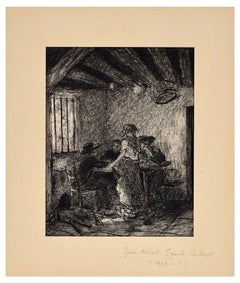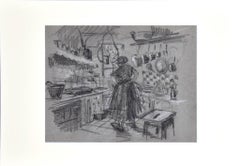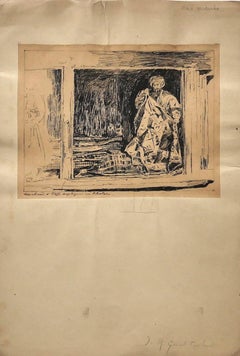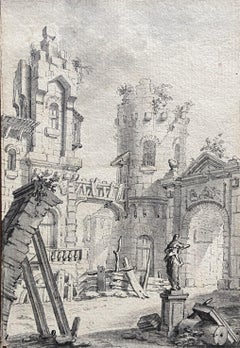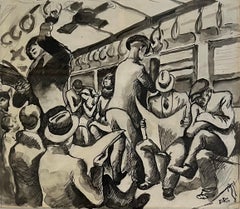Jean Albert Grand-Carteret Art
to
1
2
3
2
1
The Inn - Original China Ink on Paper by J.A. Grand-Carteret -First Half of 1900
By Jean Albert Grand-Carteret
Located in Roma, IT
The Inn is an original artwork realized by Jean Albert Grand-Carteret in the XX Century.
China Ink on paper. Passepartout included (cm 27 x 23).
Mint conditions.
Very beautiful...
Category
Mid-20th Century Jean Albert Grand-Carteret Art
Materials
Ink
Interior - Original Drawing by Jean Albert Grand-Carteret - Early 20th Century
By Jean Albert Grand-Carteret
Located in Roma, IT
Interior is an original drawing on paper, realized by Jean Albert Grand-Carteret in the early 20th Century.
The state of preservation is very good.
The artwork represents a woman i...
Category
Early 20th Century Modern Jean Albert Grand-Carteret Art
Materials
Paper, Pencil
Merchant - Original Drawing in Pen by Jean Albert Grand-Carteret - 20th Century
By Jean Albert Grand-Carteret
Located in Roma, IT
Merchant is an original drawing in pen on paper realized by the French artist Jean Albert Grand-Carteret (1903-1982)
Hand-signed on the lower right in pencil.
Image Dimensions: 14 ...
Category
Mid-20th Century Modern Jean Albert Grand-Carteret Art
Materials
Pen
Related Items
18th Century School, Courtyard of a palazzo, Architectural Capriccio, drawing
Located in Paris, FR
18th Century french School,
Courtyard of a ruined palazzo, An Architectural Capriccio,
Pen and black ink and black ink wash on paper
17 x 12 cm
In good condition
Framed : 32 x 26 c...
Category
1780s Old Masters Jean Albert Grand-Carteret Art
Materials
Ink
NYC Subway Mid 20th Century American Scene Social Realism WPA Modern 1930s
By Daniel Ralph Celentano
Located in New York, NY
NYC Subway Riders Mid 20th Century American Scene Social Realism WPA Modern 1930s
Daniel Celentano (1902 - 1980)
Subway Scene, 1930s
8 x 9 inches
Ink and wash on paper
Singed lower ...
Category
1930s American Realist Jean Albert Grand-Carteret Art
Materials
Paper, Ink, Gouache
Study for a fresco
Located in Paris, Île-de-France
Attributed to Francesco PENNI (1488 – 1528)
Study for a fresco
Pen and brown ink, brown wash heightened with white on prepared paper
14 x 12 cm
Unsigned
On the mount, handwriting ...
Category
16th Century Old Masters Jean Albert Grand-Carteret Art
Materials
Ink
Interior Bedroom Scene, Modern Graphite Drawing by John Koch
By John Koch
Located in Long Island City, NY
John Koch, American (1909 - 1978) - Interior Bedroom Scene, Year: circa 1970, Medium: Graphite on Paper, signed in pencil lower right, Size: 17 x 11 in. (43.18 x 27.94 cm), Frame ...
Category
1970s Modern Jean Albert Grand-Carteret Art
Materials
Graphite
$2,500
H 29 in W 23 in
"Steel Factory" Cuban Mid 20th Century Modern Drawing WPA Latin Art Industrial
Located in New York, NY
"Steel Factory" Cuban Mid 20th Century Modern Drawing WPA Latin Art Industrial
Ink on paper. 12 x 19 inches. Pogolotti lived in Paris in the 1930s. The drawing here comes from the collection of his Parisian ophthalmologist, Dr. Prokopenko . Unfortunately, the artist lost his eyesight in 1938.
Marcelo Pogolotti (1902–1988) was a Cuban painter...
Category
1930s Modern Jean Albert Grand-Carteret Art
Materials
Paper, Ink
Church Interior
By Ray Quigley
Located in Buffalo, NY
A modern illustration by American artist Ray Quigley depicting two men inside of a church.
Category
1950s Realist Jean Albert Grand-Carteret Art
Materials
Gouache, Illustration Board, Ink
"My Fair Lady" 1958 West End Theatre Costume Drawing Mid 20th Century Modern
By Cecil Beaton
Located in New York, NY
"My Fair Lady" 1958 West End Theatre Costume Drawing Mid 20th Century Modern
Cecil Beaton (1904 – 1980) "My Fair Lady," Pen and ink on paper. ...
Category
1950s Performance Jean Albert Grand-Carteret Art
Materials
Paper, Ink, Pen
$20,000
H 21 in W 19 in D 2 in
18th Century Roman School , A Palazzo with antiques, drawing
Located in Paris, FR
18th Century Roman School
A Palazzo with antiques
Brown ink and pen, brown ink wash on paper
12.5 x 20 cm
Framed : 28,5 x 35.5
This nice drawing represents a genre scene, with a nobleman, priests, a mother and her children...
Category
Early 18th Century Old Masters Jean Albert Grand-Carteret Art
Materials
Ink
Mid-Century French Feutre on Paper. Tea time In the Kitchen.
Located in Cotignac, FR
Late Mid Century French feutre drawing on paper of a Provençal lady sitting in her kitchen by Jean Arène. Signed and dated bottom left.
This artwork is a striking pen-and-ink drawing that vividly captures a cluttered interior scene filled with an assortment of teapots and household objects. The central figure, an elderly lady with an expressive face, sits at a table surrounded by an overwhelming array of details. The artist uses bold, dynamic lines to convey a sense of chaos and charm, creating an atmosphere of cozy clutter. The composition’s intricacy draws the viewer's eye around the room, showcasing...
Category
1960s Expressionist Jean Albert Grand-Carteret Art
Materials
Paper, Felt Pen
$1,217
H 33.94 in W 27.52 in D 0.79 in
African Mama - Vintage Illustration in Ink and Watercolor
By Irene Pattinson
Located in Soquel, CA
African Mama - Vintage Illustration in Ink and Watercolor
A charming illustration, by Irene Pattinson (American, 1909-1999), shows a woman with a...
Category
1950s American Modern Jean Albert Grand-Carteret Art
Materials
Paper, India Ink, Watercolor, Pen
$636 Sale Price
20% Off
H 13 in W 10 in D 0.25 in
"Let's Make an Opera" Original Drawing NYT Published, Norman Del Mar Conducts
By Albert Al Hirschfeld
Located in New York, NY
"Let's Make an Opera" Original Drawing NYT Published, Norman Del Mar Conducts
Al Hirschfeld (1903-2003)
"Let's Make An Opera"
Ink on board
13 1/2 x 18 1/2, sight
Framed: 22 1/2 x 27...
Category
1950s Performance Jean Albert Grand-Carteret Art
Materials
Ink, Board
Belgian Pencil Sketch - Bourgeois Salon
Located in Houston, TX
Pencil sketch of a theater set designed to depict an elegant nineteenth century sitting room, circa 1950.
Original artwork on paper displayed on a whi...
Category
1940s Jean Albert Grand-Carteret Art
Materials
Pencil, Paper
Jean Albert Grand-carteret art for sale on 1stDibs.
Find a wide variety of authentic Jean Albert Grand-Carteret available for sale on 1stDibs. You can also browse by medium to find art by Jean Albert Grand-Carteret in crayon, ink, paper and more. Much of the original work by this artist or collective was created during the 20th century and is mostly associated with the modern style. Not every interior allows for large Jean Albert Grand-Carteret, so small editions measuring 9 inches across are available. Customers who are interested in this artist might also find the work of Buscot, Daniel Ginsbourg, and Mordechai Avniel. Jean Albert Grand-Carteret prices can differ depending upon medium, time period and other attributes. On 1stDibs, the price for these items starts at $121 and tops out at $2,885, while the average work can sell for $411.
